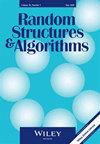Spatial mixing and the random‐cluster dynamics on lattices
IF 0.8
3区 数学
Q4 COMPUTER SCIENCE, SOFTWARE ENGINEERING
引用次数: 0
Abstract
Abstract An important paradigm in the understanding of mixing times of Glauber dynamics for spin systems is the correspondence between spatial mixing properties of the models and bounds on the mixing time of the dynamics. This includes, in particular, the classical notions of weak and strong spatial mixing, which have been used to show the best known mixing time bounds in the high‐temperature regime for the Glauber dynamics for the Ising and Potts models. Glauber dynamics for the random‐cluster model does not naturally fit into this spin systems framework because its transition rules are not local. In this article, we present various implications between weak spatial mixing, strong spatial mixing, and the newer notion of spatial mixing within a phase, and mixing time bounds for the random‐cluster dynamics in finite subsets of for general . These imply a host of new results, including optimal mixing for the random cluster dynamics on torii and boxes on vertices in at all high temperatures and at sufficiently low temperatures, and for large values of quasi‐polynomial (or quasi‐linear when ) mixing time bounds from random phase initializations on torii at the critical point (where by contrast the mixing time from worst‐case initializations is exponentially large). In the same parameter regimes, these results translate to fast sampling algorithms for the Potts model on for general .格上的空间混合和随机簇动力学
自旋系统的格劳伯动力学混合时间的一个重要理解范式是模型的空间混合特性与动力学混合时间界的对应关系。这包括,特别是,弱和强空间混合的经典概念,这已经被用来显示最著名的混合时间界限在高温条件下的格劳伯动力学的Ising和Potts模型。随机-簇模型的Glauber动力学并不适合这种自旋系统框架,因为它的跃迁规则不是局部的。在本文中,我们提出了弱空间混合、强空间混合和一个阶段内空间混合的新概念之间的各种含义,以及一般的有限子集中随机簇动力学的混合时间界限。这意味着一系列新的结果,包括在所有高温和足够低的温度下,顶点上的torii和boxes上的随机簇动力学的最优混合,以及在临界点上torii上随机相位初始化的大值拟多项式(或拟线性)混合时间界限(相比之下,最坏情况初始化的混合时间是指数大)。在相同的参数制度,这些结果转化为快速采样算法的Potts模型对一般。
本文章由计算机程序翻译,如有差异,请以英文原文为准。
求助全文
约1分钟内获得全文
求助全文
来源期刊

Random Structures & Algorithms
数学-计算机:软件工程
CiteScore
2.50
自引率
10.00%
发文量
56
审稿时长
>12 weeks
期刊介绍:
It is the aim of this journal to meet two main objectives: to cover the latest research on discrete random structures, and to present applications of such research to problems in combinatorics and computer science. The goal is to provide a natural home for a significant body of current research, and a useful forum for ideas on future studies in randomness.
Results concerning random graphs, hypergraphs, matroids, trees, mappings, permutations, matrices, sets and orders, as well as stochastic graph processes and networks are presented with particular emphasis on the use of probabilistic methods in combinatorics as developed by Paul Erdõs. The journal focuses on probabilistic algorithms, average case analysis of deterministic algorithms, and applications of probabilistic methods to cryptography, data structures, searching and sorting. The journal also devotes space to such areas of probability theory as percolation, random walks and combinatorial aspects of probability.
 求助内容:
求助内容: 应助结果提醒方式:
应助结果提醒方式:


